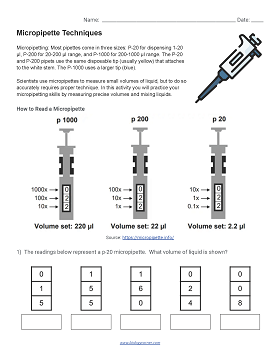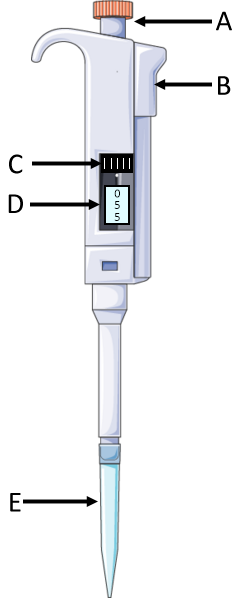
A micropipette is a laboratory instrument used for accurately and precisely measuring and transferring small volumes of liquid, typically in the microliter range. Micropipettes have a volume range between 1 and 1000 µl, allowing for accurate measurement of small amounts of liquids.
Most pipettes come in three sizes: P-20 for dispensing 1-20 μl, P-200 for 20-200 μl range, and P-1000 for 200-1000 μl range. The P-20 and P-200 pipets use the same disposable tip (usually yellow) that attaches to the white stem. The P-1000 uses a larger tip (blue).
Students may encounter micropipettes in lab activities that involve DNA and electrophoresis. Micropipettes transfer small DNA samples to wells. They may use larger pipettes for basic volume transfer, like the kind used in the water strider lab.
Micropipette Technique
Using a micropipette can be challenging. There are many different sizes and designs, but they all function in the same way. In my classroom, I have micropipettes that I have gathered from donations and purchased. Note: laboratory grade equipment can be very expensive, but you can buy cheap micropipettes on Amazon. Those will work for most things in a high school biology lab.
If you want to give your students a basic guide to using a micropipette, you can download this worksheet (copy to google drive to edit). The first section explain how to read the device for p20, p200, and p1000 versions. Generally, the ones I use in class are p20.
The second section outlines the parts of the micropipette and how to draw and dispense samples. Students learn to use the first stop to draw in the liquid. Then they use the second stop to expel the liquid. They also learn how to adjust the volume of the tool by rotating the wheel on the device until the window reads the desired volume.

This section also includes a labeling of a micropipette.
A = plunger
B = tip ejector
C = volume adjustment
D = volume
E = micropipette tip
The last section includes a template for practicing micropipette skills. Students use food dye to create dots on a paper template. They’ll practice changing the volume on the device, mixing liquids, and tip disposal. Place the template in a plastic sleeve for easy cleanup.
I have dry erase pockets for this and lots of other projects in my classroom. You can also download art templates from miniPCR for student to get creative!

